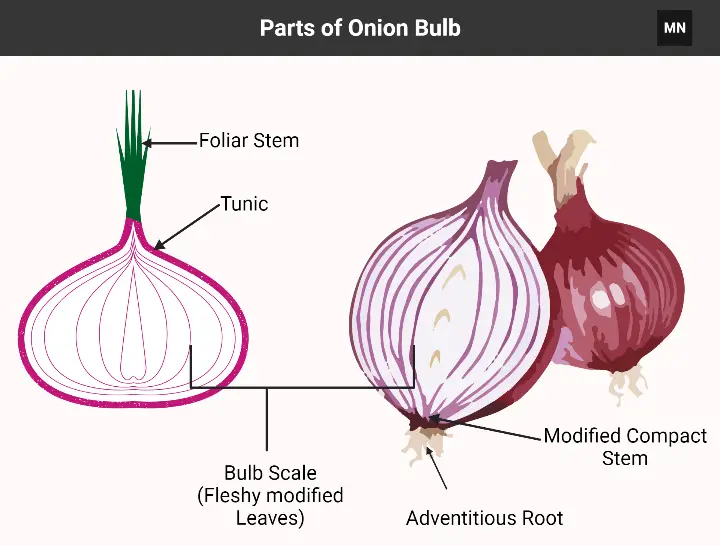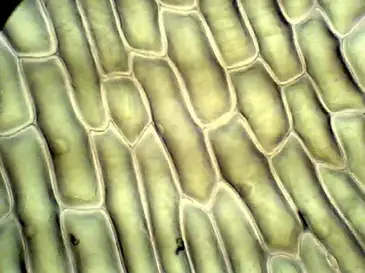Onion cells under a microscope offer a classic and revealing glimpse into plant anatomy, showing clear rectangular cells with defined walls and central nuclei, and that somewhat large central vacuole, as students often note. Since the onion bulb isn’t meant for photosynthesis its epidermal cells lack chloroplasts, making its cell membrane, cytoplasm, nucleus positioned at the periphery, cell wall and vacuole easy to see. A simple wet‑mount slide stained with iodine or safranin enhances contrast, so you can see the cell boundaries and nuclei more distinctly even under medium magnifications. This kind of preparation introduces learners to essential microscopy techniques and plant cell structure, letting them visualize cellular organization and compare plant cell features like cell walls and vacuoles in a straightforward, cost‑effective way.

Objective of this Experiment
- Learn about the structure of cells under a microscope by looking at the main parts of an onion epidermal cell, such as the cell wall, nucleus, cytoplasm, and vacuole.
- Learn how to correctly handle specimens, stains (such iodine), and cover slips so that you can get clean, focused pictures when you practice making wet-mount slides.
- Identify and compare plant-specific traits, including the stiff cell wall and big central vacuole, that are typical of plant cells.
- Improve your microscopy abilities by learning how to change the focus, light, and magnification on a compound microscope for biological investigations.
- Strengthen scientific documentation by precisely recording findings, drawing annotated diagrams, and connecting structural features to known cell function.

What do onion cells look like under the microscope?
- Cell shape – rectangular, elongated, well-defined, forming a honeycomb-like pattern.
- Cell wall – thick, rigid, cellulose-based, clearly visible, providing structural support.
- Cytoplasm – thin, colorless layer, surrounding the central vacuole.
- Nucleus – small, round, located at the periphery of the cytoplasm
- Vacuole – large, central, occupying most of the cell’s interior, prominent in plant cells.
- Staining – often treated with iodine to enhance contrast, making structures more visible
- Arrangement – cells arranged in a single layer, forming the epidermis of the onion bulb
- Transparency – naturally transparent, allowing for clear observation under a microscope.
- Lack of chloroplasts – due to the onion bulb’s role in storage, not photosynthesis.
How to Observe Onion Cells under a Microscope?
Requirements
- Microscope – a light microscope with at least 40x magnification is essential to observe the cellular structures of onion cells.
- Onion – a fresh onion bulb is needed; the epidermal layer of the onion is typically used for observation.
- Microscope Slide – standard glass slides (75mm x 25mm) are used to mount the onion peel for examination.
- Cover Slip – a thin glass cover slip is placed over the specimen to protect the lens and prevent contamination.
- Forceps – used to handle the delicate onion peel without contamination.
- Iodine Solution – a staining agent like iodine enhances the visibility of cell structures by providing contrast.
- Pipette or Dropper – for applying the iodine solution onto the specimen.
- Paper Towel – used to blot excess liquid and to press down the cover slip gently, avoiding air bubbles.
- White Tile or Plate – provides a clean surface to work on and aids in cutting the onion peel.
- Safety Equipment – safety glasses are recommended to protect eyes from potential irritants like iodine.
- Notebook and Pencil – for recording observations and drawing diagrams of the observed cells.
- Optional: Prepared Slides – pre-made slides of onion epidermal cells can be used for comparison or if immediate observation is needed.
Other alternative Stains;
- Iodine (Lugol’s solution) – classic, household‑available stain that highlights nuclei and cell walls well, widely recommended in many protocols.
- Ink (water‑based black ink) – works as a negative stain: cells absorb ink making cytoplasm/nuclei dark while background remains light, per Wikibooks method.
- Methylene blue – commonly used basic dye for contrast; available in aquariums or labs, stains nuclei in onion cells.
- Malachite green – another accessible stain (fish cure) that gives greenish tint to cellular components
- Safranin – cost‑effective, stains nucleic acids red; especially good for root‑tip chromosome visualization but also usable on epidermal cells
- Acetocarmine / Aceto‑orcein – traditional stains for chromosomal details in root tips; stronger and more specialized
- Carbol fuchsin, toluidine blue, Feulgen stain – suggested in histology discussions as alternatives to carmine for DNA/nucleus staining
- Thionine (Lauth’s violet) – metachromatic dye related to methylene blue; an option for visualizing nuclei
- Natural stains (e.g., beetroot extract) – emerging option; use fluorescent pigment from beetroot demonstrated in cell imaging, though less common for onion cells
Procedure
- Assemble your materials – collect a fresh onion bulb, a microscope slide, a cover slip, forceps, iodine stain, a dropper, and a light microscope.
- Carefully remove the epidermis – utilize forceps to delicately separate a thin, transparent layer of epidermis from the inner surface of the onion bulb.
- Position the thin onion epidermis flatly at the center of a pristine glass slide with precision.
- Enhance contrast by adding a stain—simply use a dropper to apply one or two drops of iodine solution onto the onion peel.
- Carefully position the cover slip by lowering it at an angle onto the stained onion peel, ensuring that air bubbles are avoided.
- Eliminate any excess liquid by gently blotting the extra stain around the edges with a tissue or paper towel, ensuring the slide remains undisturbed.
- Position the slide on the microscope stage and secure it firmly using the stage clips.
- Begin with minimal power—concentrate on the lowest magnification (typically 4x or 10x) to identify the cells.
- Refine your focus – gradually enhance the magnification to 40x or beyond, and meticulously fine-tune the focus to reveal intricate cell details.
- Carefully examine and document your findings – identify the cell wall, nucleus, cytoplasm, and vacuole, then create precise drawings and detailed notes of your observations.
- Ensure a thorough cleanup: After your observation, meticulously clean the slide, cover slip, and microscope to prepare them for future use.
- To ensure a safe experience, remember to avoid direct skin contact with iodine, handle glassware with care, and wash your hands thoroughly after completing the experiment.

Result
- Cells exhibit a rectangular and elongated shape, creating a honeycomb-like pattern.
- The cell wall is a robust and rigid structure, composed of cellulose, and is distinctly visible, offering essential structural support.
- The cytoplasm is a delicate, transparent layer that encases the central vacuole.
- The nucleus is a small, round structure situated at the edge of the cytoplasm.
- The vacuole is a large, central structure that occupies a significant portion of the cell’s interior, particularly prominent in plant cells.
- Staining is frequently enhanced with iodine to boost contrast, allowing for clearer visibility of structures.
- Cells are meticulously arranged in a single layer, creating the epidermis of the onion bulb.
- Clear and naturally transparent, enabling effortless observation under a microscope.
- Absence of Chloroplasts – attributed to the onion bulb’s function in storage rather than photosynthesis


Precautions
These are important, and you don’t wanna mess up your experiment or get hurt while observing onion cells under microscope
- Handle glassware carefully – glass slides and cover slips can be sharp so don’t touch edges directly or you might get cut
- Use clean tools and slides – dirty or wet slides cause blurry images, so make sure everything’s dry and clean before use
- Avoid air bubbles – put the cover slip slowly at an angle to prevent bubbles that mess up your view
- Handle stains with care – iodine and others can irritate skin and eyes, so wear gloves and try not to inhale fumes
- Dispose stuff properly – don’t just toss used slides or stains in the trash, follow safety rules or it can harm environment or people
- Keep microscope clean – dirty lenses or stage reduce clarity, so clean them regularly but gently
- Be careful with sharp tools – forceps or scalpels can poke or cut you if not handled cautiously
- Follow lab safety protocols – always stick to your institution’s safety guidelines, don’t skip them no matter what
Onion Cells Under a Microscope Video
FAQ
What is the onion peel cell experiment?
The onion peel cell experiment is a common educational activity where students observe and study the cellular structure of onion epidermal cells under a microscope.
Why use onion peel for this experiment?
Onion peel is used because it consists of a single layer of cells that are easy to separate and observe. Additionally, the large size of onion cells allows for examination under low magnification.
What materials are needed for the experiment?
The materials needed include an onion, knife, forceps, Petri plate, distilled water, safranin stain, clean glass slide, glycerine, coverslip, blotting paper, and a compound microscope.
How is the onion peel prepared for observation?
To prepare the onion peel, a thin, transparent epidermal layer is carefully pulled from the onion bulb’s scale leaf using forceps and washed in water.
What is the purpose of staining the onion peel?
Staining the onion peel with safranin enhances the visibility of cellular structures, making it easier to observe and study the different components of the cell.
How do you mount the stained onion peel on a glass slide?
To mount the stained onion peel, a drop of glycerine is added to the center of the slide, and the peel is carefully placed on it. A cover slip is then placed over the peel to protect it and avoid air bubbles.
What precautions should be taken during the experiment?
Precautions include not overstaining the onion skin, avoiding folding of the peel, using dry and clean glass slides and coverslips, and removing excess glycerine using blotting paper.
How do you observe the temporary slide under the compound microscope?
To observe the temporary slide, turn on the microscope’s light, ensure the low objective lens is in line with the optical tube, and carefully place the slide on the stage. Adjust the focus for clarity and switch to a higher objective lens for greater magnification if needed.
What features can be observed in the onion peel cells?
Features that can be observed include the rectangular shape of cells, the compact arrangement with no intercellular spaces, the presence of a distinct cell wall, a prominent nucleus, and a large vacuole.
Why is the onion peel cell experiment valuable for students?
The experiment provides students with a hands-on opportunity to study plant cell structures and gain a deeper understanding of plant anatomy. It also helps students practice microscope usage and observation skills, fostering an appreciation for the microscopic world.
- Text Highlighting: Select any text in the post content to highlight it
- Text Annotation: Select text and add comments with annotations
- Comment Management: Edit or delete your own comments
- Highlight Management: Remove your own highlights
How to use: Simply select any text in the post content above, and you'll see annotation options. Login here or create an account to get started.